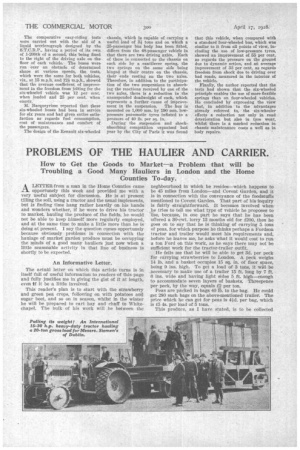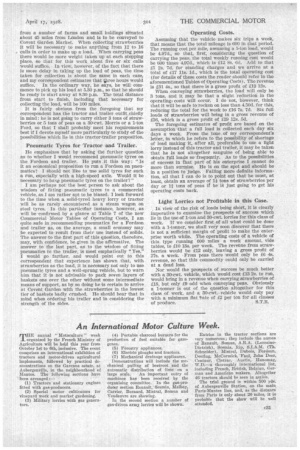PROBLEMS OF THE HAULIER AND CARRIER.
Page 52

Page 53

If you've noticed an error in this article please click here to report it so we can fix it.
How to Get the Goods to Market--t Problem that will be Troubling a Good Many Hauliers in London and the Home Counties To-day.
A LETTER from a man in the Home Counties came Cl opportunely this week and provided me with a very useful subject for discussion. He is at present tilling the soil, using a tractor and the usual implements, but is finding time hang rather heavily on his hands and wonders whether, if he were to drive his tractor to market, hauling the produce of the fields, he would not be able to keep himself more regularly employed, and at the same time to make a little more than he is doing at present. 1 say the question comes opportunely because obviously problems in connection with the haulage of market garden produce must be occupying the minds of a good many hauliers just now when a little seasonable activity in that tine of business is shortly to be expected.
An Informative Letter.
The actual letter on which this article turns is in itself full of useful information to readers of this page and fully justifies me in giving the gist of it at length, even if it be a little involved.
This reader's plan is to start with the strawberry and green pea crops, following on with potatoes and sugar beet, and so on in season, whilst in the winter he will be prepared to cart hay and chaff to Whitechapel. The bulk of his work will be between the
neghbourhood in which he resides—which happens to be 45 miles from London—and Covent Garden, and it is in connection with the conveyance of the foodstuffs mentioned to Covent Garden. That part of his inquiry is fairly straightforward. It becomes involved when he tries to tell me what type of vehicle he proposes to use, because, in one part he says that be has been offered a 30-cwt. lorry 13 months old for £200, then he goes on to say that he is thinking of carrying 5 tons of peas, for which purpose he thinks perhaps a Fordson tractor and trailer would meet his requirements and, before he leaves me, he asks what it would CO8t to run a ton Ford on this work, as he says there may not be sufficient work for the tractor-trailer outfit.
He tells me that he will be able to get 3d. per peck for carrying strawberries to London. A peek weighs 14 lb. and a basket occupies 15 sq. in. of floor space, being 9 ins. high. To get a load of 3 tons, it will be necessary to make use of a trailer 15 ft. long by 7 ft. 6 ins, wide and having light sides 5 ft. high—enough to accommodate seven layers of baskets. Threepence per peck, by the way, equals £2 per ton.
Peas are packed in bags 40 lb. to the bag. He could get 280 such bags on the above-mentioned trailer. The price which he can get for peas is 41d. per bag, which is £5 4s. per load of 5 tons.
This produce, as I have stated, is to be collected from a number of farms and small holdings situated about 45 miles from London and is to be conveyed to Covent Garden Market. When collecting strawberries it will be necessary to make anything from 12 to 16 calls in order to make up a load. When carrying peas there would be more weight taken up at each stopping place, so that for this work about five or six calls would suffice. In view, however, of the fact that there is more delay in taking up the load of peas, the time taken for collection is about the same in each case, and my correspondent estimates that tjaree hours would suffice. In the ordinary way, he says, he will commence to pick up his load at 5.30 p.m., so that he should be ready to start away at 8.30 p.m. The total distance from start to finish, including that necessary for collecting the load, will be 100 miles.
It is fairly obvious from the foregoing that my• correspondent has the tractor and trailer outfit chiefly in mind : he is not going to carry either 3 tons of strawberries or 5 tons of peas on a 30-cwt. Morris or a 1-ton Ford, so that I shall probably meet his requirements best if I devote myself more particularly to study of the possibilities which lie in this tractor-trailer proposition.
Pneumatic Tyres for 'Tractor and Trailer.
He emphasizes that by asking the further question as to whether I would recommend pneumatic tyres on the Fordson and trailer. He puts it this way : "Is it an economical proposition to run a Fordson on pneumatics? I should not like to use solid tyres for such a run, especially with a high-speed axle. Would it be necessary to have pneumatic tyres on the trailer?"
I am perhaps not the best person to ask about the wisdom of fitting pneumatic tyres to a commercial vehicle, as I am rather apt to be biased. I look forward to the time when a solid-tyred heavy lorry or tractor will be as rarely encountered as a steam wagon on steel tyres. In this particular instance, however, as will be confirmed by a glance at Table 7 of the new Commercial Motor Tables of Operating Costs, I am quite safe in recommending pneumatics for a Fordson and trailer as, on the average, a small economy may be expected to result from their use instead of solids. The answer to the first part of this question, therefore, may, with confidence, be given in the affirmative. The answer to the last part, as to the wisdom of fitting pneumatics to the trailer, is most emphatically "Yes." I would go farther, and would point out to this correspondent that experience has shown that, with strawberries as the load, it is neCessary not only to use pneumatic tyres and a well-sprung vehicle, but to warn him that it is not advisable to pack seven layers of baskets one over the other without some intermediate means of support, as by so doing he is certain to arrive at Covent Garden with the strawberries in the lowest tier of baskets badly crushed. He should bear that in mind when ordering his trailer and in considering the strength of the sides.
•
Operating Costs.
Assuming that the vehicle makes six trips a week, that means that the total mileage is 600 in that period. The running cost per mile, assuming a 5-ton load, would be 4.97d., so that, first, considering the question of carrying the peas, the total weekly running cost would be 600 times 4.97d., which is £12 85. 6d. Add to that £5 2s. 7d. for standing charges and we arrive at a total of £17 lb. 1d., which is the total operating COSt (for details of these costs the reader should refer to the aforementioned Tables of Operating Costs). The revenue is 131 4s., so that there is a gross profit of in 13s.
When conveying strawberries, the load will only be 3 tons, and it may be that a slight reduction in the operating, costs will occur. I do not, however, think that it will be safe to reckon on less than 4.50d. for this, reducing the total for the week to £16 7s. 7d. Six full loads of strawberries will bring in a gross revenue of £36, which is a gross profit of 119 12s. 5d.
The foregoing estimates of profit are based on the assumption that a full load is collected each day six days a week. From the tone of my correspondent's letter, in which he refers to the possibility of shortage of load making it, after all, preferable to use a light lorry instead of this tractor and trailer, it may be taken that he is not altogether sanguine of being able to obtain full loads so frequently. As to the possibilities of success in that part of his enterprise I cannot do more than surmise. He is on the spot and should be in a position to judge. Failing more definite information, all that I can do is to point out that he must, at least, obtain an average of 11 tons of strawberries per day or U tons of peas if he is just going to get his operating costs back.
Light Lorriec4 not Profitable in this Case.
In view of the risk of loads being short, it is clearly imperative to examine the prospects of success which lie in the use of 1-ton and 30-cwt. lorries for this class of work. If we consider first of all what could be done with a 1-tonner, we shall very soon discover that there is not a sufficient margin of profit to make the enterprise worth while. The operating costs of a vehicle of this type running 600 miles a week amount, vide tables, to £10 13s. per week. The revenue from strawberries would be £12 only, leaving a gross profit of 27s. a week. From peas there would only be £6 4s. revenue, so that this commodity could only be carried at a dead loss.
Nor would the prospects of success be much better with a 30-cwt. vehicle, which would cost 113 2s. to run, would bring in a revenue when carrying strawberries of £18, but only 19 odd when conveying peas. Obviously a 1-tonner is out of the question altogether for this class of work, and a 30-cwt.. vehicle would only pay with a minimum flat 'late of 12 per ton for all classes
of produce. S.T.R.












































































































